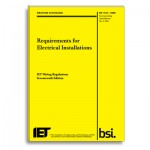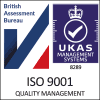17th Edition Wiring Regulations Amendment 3: What’s Changing?

With some major changes coming to the 17th Edition Wiring Regulations from Amendment 3, due to be announced on 1st November, what will this mean for those of us already in the industry?
 Well, until the final details of these changes are announced in a few weeks time, we can only speculate as to what might be included. However, the proposed changes, which were announced last year, are available and may offer a clue as to what could be included with this update.
Well, until the final details of these changes are announced in a few weeks time, we can only speculate as to what might be included. However, the proposed changes, which were announced last year, are available and may offer a clue as to what could be included with this update.
Undoubtedly these changes will mean new training workshops will be need to be taken by those working to 17th Edition standards, to ensure all work continues to current standards.
While we are all eagerly anticipating the release of amendment 3, let’s take a look at some of the potential changes to the current 17th Edition Regulations.
Part 2 Definitions –This section could be expanded and modified with some of the terminology changing to avoid confusion and promote further clarity.
Chapter 52 Selection and Erection of the Wiring Cables: Cables concealed in a wall or partition -This section could be rewritten and all references to the phrase ‘under the supervision of skilled and instructed persons’ may be removed.
Section 557 Auxiliary Circuits – This section is a proposed new addition to the regulations and will cover things like auxiliary circuits for low voltage electrical installations. These types of circuits are for the transmission of signals intended for the detection, supervision or control of the functional status of a main circuit.
Section 717 Mobile and Transportable Units – This covers units which are self propelled, towed or transportable containers or cabins. Risk reduction requirements include automatic disconnection by RCD, accessible conductive parts to be connected through equipotential bonding to the main earth terminal within the unit, and the type of supply, voltage rating, number of phases, on board earthing and maximum power required.
Section 559, 714 and 715: Luminaires and Lighting Installations – Changes are proposed to bring this section together with the latest IEC and CENELEC standards.
Section 715 Extra-low Voltage Lighting – This refers to installations supplied from sources with maximum rated voltage of 50Vac rms or 120Vdc. Changes are expected to go along with the latest IEC and CENELEC standards.
Section 714 Outdoor Lighting Installations – Only minor changes are proposed in this section including things like requiring individual circuits to be isolated.
Chapter 41 Protection against Electric Shock – It is proposed that any reference to ‘ordinary persons’ is removed and protection for socket outlets up to 20A for all installations is required. However, those with RCD protection for specific labelled socket outlets or where a risk assessment has decided that RCD protection is not necessary are exempt.
‘Cmin’ Factor – It is proposed that the maximum earth fault loop impedance is revised to account for the Cmin factor. Notes on the tables will be changed to reflect maximum permitted operating temperature.
Chapter 42 Protection against Thermal Effects – Regulation 421.1200 requires switchgear assemblies including consumer units to have their enclosure manufactured from non combustible material to help protect against fire.
Condition Report – A few changes are proposed to the electrical installation condition report and notes. It proposes changes to the certification of new work – the schedule of inspections for new work to be replaced by examples of items that require inspection during initial verification.
There may be some other changes included in amendment 3 not listed here and some of those here may not be included in the final publication. We won’t know for certain until the details are published in November.
In the meantime, if you are interested in updating your skills to incorporate the new amendment 3, let us know and we’ll publish details of our course as soon as it’s available.
Written by Sara Thomson







